It’s been over 10,000 years since humans started domesticating crops to make food taste better, be healthier, and grow in different environments. However, these genetic modifications have also made fruits and vegetables look different from the wild varieties that used to exist.
Although there has been certain bad press about genetically modified food (GMOs), folks can’t deny the amazing results. Just look at these before and after photos, which are a testament to the incredible changes our food has undergone over the years.
This post may include affiliate links.
Corn
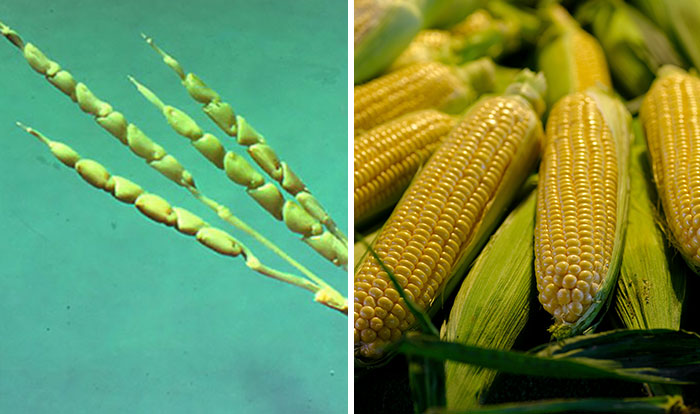 The delicious corn we know today has come a long way and looks very different from its ancestors. Early records say that corn was domesticated at least 8,700 calendar years ago by indigenous peoples in Mexico. The original varieties had hard kernels, tasted like dry raw potatoes, and were very small.
The delicious corn we know today has come a long way and looks very different from its ancestors. Early records say that corn was domesticated at least 8,700 calendar years ago by indigenous peoples in Mexico. The original varieties had hard kernels, tasted like dry raw potatoes, and were very small.
Now, the crop is bred in a variety of colors, is about 1,000 times bigger, and has almost 200 varieties. The kind of modern or hybrid corn we have today became more popular around 1933.
Banana
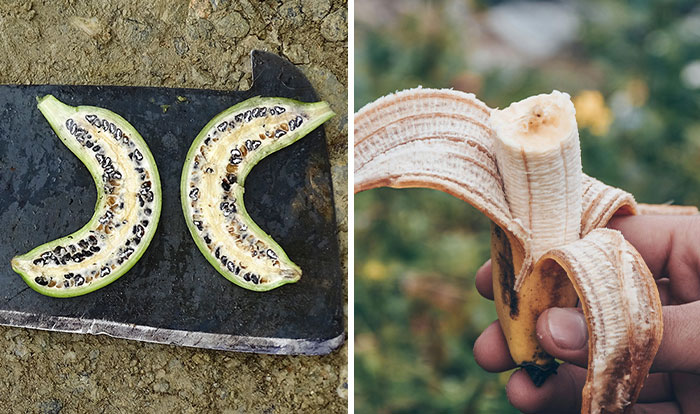 Our old faithful banana’s ancestors date back some 7000 years to Musa in Southeast Asia. Before it was the creamy, sweet fruit we know and love, it actually housed large seeds that took up most of the space inside. Humans have worked hard to keep bananas safe from extinction and developed the Giant Cavendish variety after a fungus infection in the previous century threatened to wipe out plantations.
Our old faithful banana’s ancestors date back some 7000 years to Musa in Southeast Asia. Before it was the creamy, sweet fruit we know and love, it actually housed large seeds that took up most of the space inside. Humans have worked hard to keep bananas safe from extinction and developed the Giant Cavendish variety after a fungus infection in the previous century threatened to wipe out plantations.
That’s why, up until the 1950s, people were still eating a different variety of bananas called the Gros Michel. It was a sweeter and more delicate variety compared to the Cavendish.
And now Cavendish may be in trouble due to fungal infection and climate change.
Apple
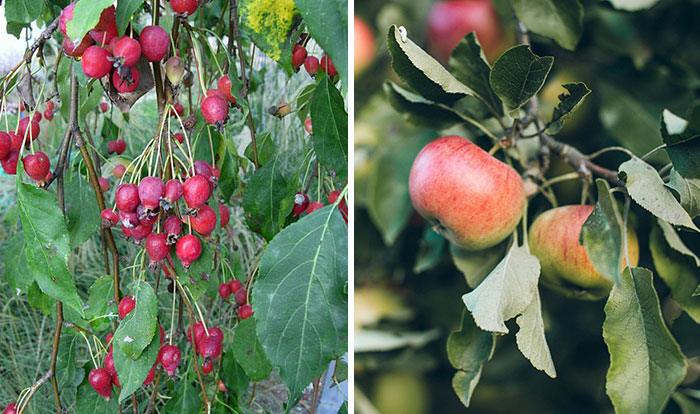 Archaeological evidence places early apple seeds in a village in the Tian Shan Mountains in Kazakhstan. It’s believed that apples were domesticated there almost 10,000 years ago. Around 300 BC, the Romans deliberately started breeding apple varieties to get better-tasting fruits.
Archaeological evidence places early apple seeds in a village in the Tian Shan Mountains in Kazakhstan. It’s believed that apples were domesticated there almost 10,000 years ago. Around 300 BC, the Romans deliberately started breeding apple varieties to get better-tasting fruits.
Researchers also think that humans helped increase the fruit’s growing range by spreading its seeds and pollen while traveling, which led to a massive growth of wild apples.
All edible apples are clones BTW, There's a great book that covers this by Michael Pollan called Botany of Desire. He covers the history of Apples, Potatoes, and Cannabis. Johnny Appleseed, it wasn't about the apples, it was all about the hard apple cider that you can make from them.
The genetically modified fruits and vegetables in this list show just how creative and intelligent human beings can be. Domesticating ancient crops has helped create a larger supply of food, reduced the need for pesticides, and created stronger plant varieties. It’s not just food that’s been selectively bred; humans have also undertaken these experiments on animals and microorganisms.
Lemon
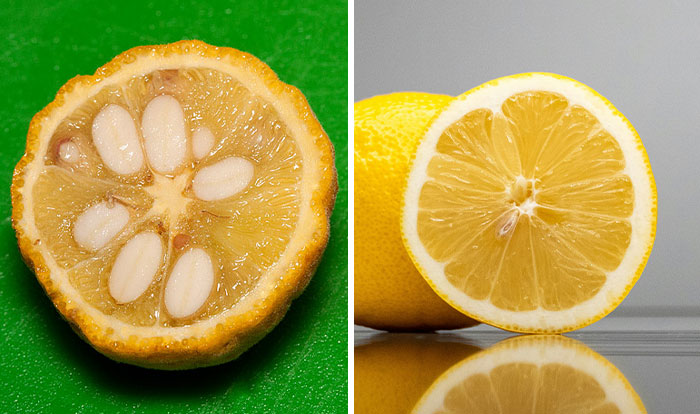 Lemons are thought to be a cross between wild citrus and bitter oranges. They first appeared in Asia and were domesticated almost 3,300 years ago. The ancient wild lemons were so acidic that they could not be eaten, and it’s kind of a mystery how the sweet varieties came into existence. Even if we can’t pinpoint how exactly they developed into what they are now, we’re incredibly thankful for all the citrusy hybrids and varieties that came from those ancestral fruits.
Lemons are thought to be a cross between wild citrus and bitter oranges. They first appeared in Asia and were domesticated almost 3,300 years ago. The ancient wild lemons were so acidic that they could not be eaten, and it’s kind of a mystery how the sweet varieties came into existence. Even if we can’t pinpoint how exactly they developed into what they are now, we’re incredibly thankful for all the citrusy hybrids and varieties that came from those ancestral fruits.
A mystery how? My coworker has an orange tree and a lemon tree and they cross pollinated and now he has crazy huge sweet lemons. And apparently gross oranges, but it's definitely not a mystery how they hybridized.
Cabbage
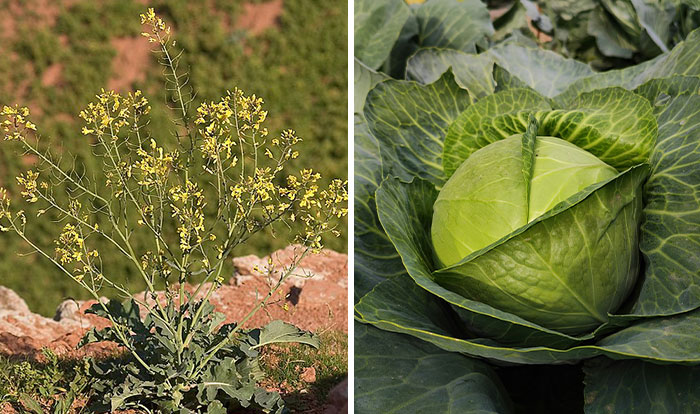 The modern fleshy and full cabbage that we use for salads was likely domesticated in Europe before 1000 BC. It was then observed that the first ‘round-headed cabbages’ similar to the ones we have today appeared in the 14th century in Europe. They were then brought to America by a French explorer in 1541.
The modern fleshy and full cabbage that we use for salads was likely domesticated in Europe before 1000 BC. It was then observed that the first ‘round-headed cabbages’ similar to the ones we have today appeared in the 14th century in Europe. They were then brought to America by a French explorer in 1541.
Vegetables like broccoli, cauliflower, cabbage, kale, and others are said to have originated from the Brassica oleracea species. The wild version of cabbage used to predominantly grow near limestone sea cliffs because it apparently had a high tolerance for salt and lime.
One of my mom's old cook books from the 70's describes broccoli something like this (rough translation from German): "If you can find it, you must try 'broccoli', also known as 'asparagus cabbage'. The lush green florets delight the eye, while the tender stems surprise with an asparagus flavour". One of the first instances that made me realise that quite a lot of fruit and vegetables hadn't always been around... although I never noticed broccoli tasting anything like asparagus.
Plum
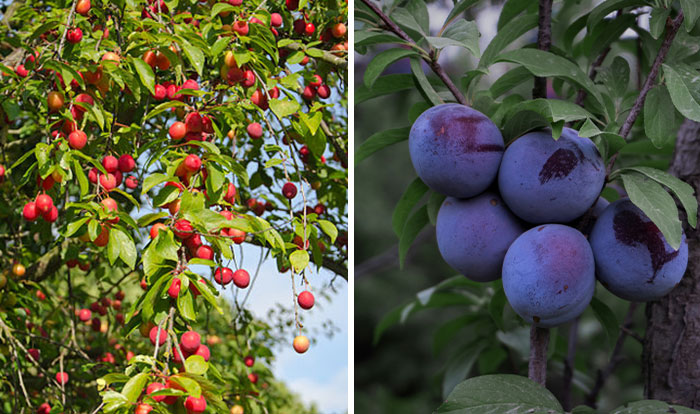 The delicious and sweet modern plum may have been one of the first fruits humans domesticated. Ancient writings show that plums were originally cultivated around Damascus. Plum remains, along with olives, figs, and grapes, have even been traced back to the Neolithic age.
The delicious and sweet modern plum may have been one of the first fruits humans domesticated. Ancient writings show that plums were originally cultivated around Damascus. Plum remains, along with olives, figs, and grapes, have even been traced back to the Neolithic age.
It was during the 19th and early 20th centuries that botanists took an interest in crossbreeding plums and ended up developing a sweet plum-apricot hybrid. These experimentations with the fruit continued and have ultimately led to the wonderful plums we have today.
The U.S. Department of Agriculture (USDA) states that GMO seeds are used to grow over 90% of the crops people consume in the United States. Despite the benefits of domesticated crops, people still worry about their potential risks.
Folks believe that GMO foods contain foreign genes that can cause people to have allergic reactions or increase the risk of certain cancers. A few studies support these claims, but the majority of research debunks them. There have also been concerns over such crops negatively impacting honeybees, but the science is still out on that one.
Carrot
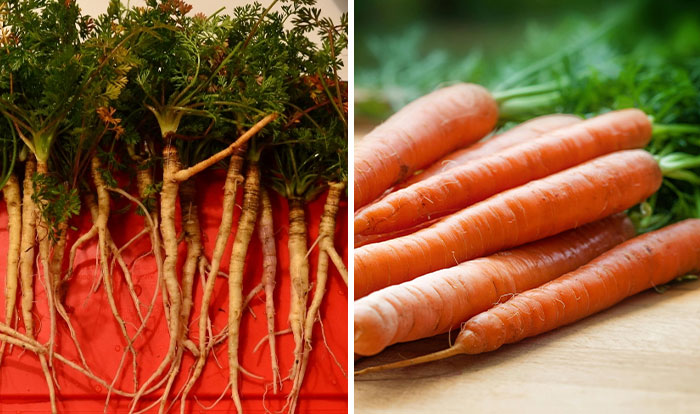 Early domesticated carrots in the East were often interesting colors like purple or yellow, while carrots in the West were predominantly orange. The wild version of this vegetable was whitish or ivory-colored and had a forked root. The modern orange carrot that we have today is credited to Dutch growers who developed it at the turn of the 18th century.
Early domesticated carrots in the East were often interesting colors like purple or yellow, while carrots in the West were predominantly orange. The wild version of this vegetable was whitish or ivory-colored and had a forked root. The modern orange carrot that we have today is credited to Dutch growers who developed it at the turn of the 18th century.
They are said to have created this variety to honor the Dutch flag at that time, but other sources claim that it was done because these carrots didn’t brown soups and stews like the purple carrots did. Regardless, we’re lucky farmers managed to domesticate carrots, weed out the forked versions, and develop them into the tasty orange vegetables we enjoy!
Wiki claims: "When they were first cultivated, carrots were grown for their aromatic leaves and seeds rather than their roots." I find that curious, because the leaves are considered waste or animal fodder today.
Cucumber
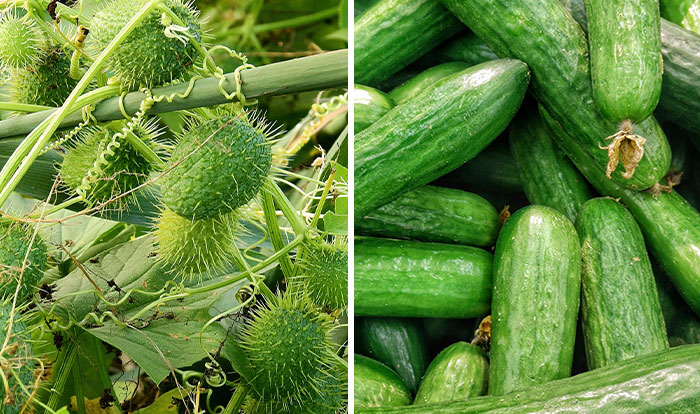 The healthy cucumber that we love adding to salads was domesticated in Asia approximately 3,000 years ago. There are old records of cucumbers being artificially grown by Romans to be eaten or used as medicine. An etching from 1772 shows the wild plant to have had smaller bean-shaped fruits and beautiful yellow flowers.
The healthy cucumber that we love adding to salads was domesticated in Asia approximately 3,000 years ago. There are old records of cucumbers being artificially grown by Romans to be eaten or used as medicine. An etching from 1772 shows the wild plant to have had smaller bean-shaped fruits and beautiful yellow flowers.
Early cucumbers often had a bitter taste because of compounds they contained called cucurbitacins. Plant breeders have used genetic modification to try and eliminate the bitter taste and additionally developed “burpless” cucumbers in the 20th century.
Watermelon
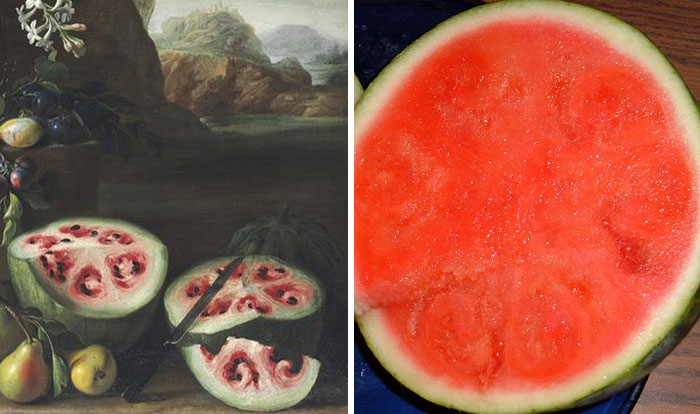 The juicy watermelon we have today was first domesticated in Africa and later cultivated in Egypt around 2000 BC. The wild varieties were not sweet and had a lot more of the inedible white rind. It was around 1576 that Spanish settlers grew watermelons similar to what we have today.
The juicy watermelon we have today was first domesticated in Africa and later cultivated in Egypt around 2000 BC. The wild varieties were not sweet and had a lot more of the inedible white rind. It was around 1576 that Spanish settlers grew watermelons similar to what we have today.
Also, during the 20th century, the USDA funded a watermelon breeding project in Charleston, which led to the creation of a large, oval-shaped, light-green melon. That ‘Charleston Grey’ melon is still widely planted today. Over the years, this kind of selective breeding has helped us get the delicious, sweet watermelons we love, along with even tougher disease-resistant varieties.
Apart from the theories and debates that most people have about genetically modified food, one of the biggest concerns actually relates to GMO seeds. People who try to avoid GMOs might inadvertently still consume them because of the hardiness of the seeds. An early example of this dates back to 1999 when Thai scientists found unapproved glyphosate-resistant GM wheat in a grain shipment.
This happened because GMO seeds tend to spread beyond their area of cultivation. Despite farmers trying their best to control GMOs, what happened in Thailand has also taken place in several countries, supermarkets, restaurants, and other places where GMOs were not approved.
Peach
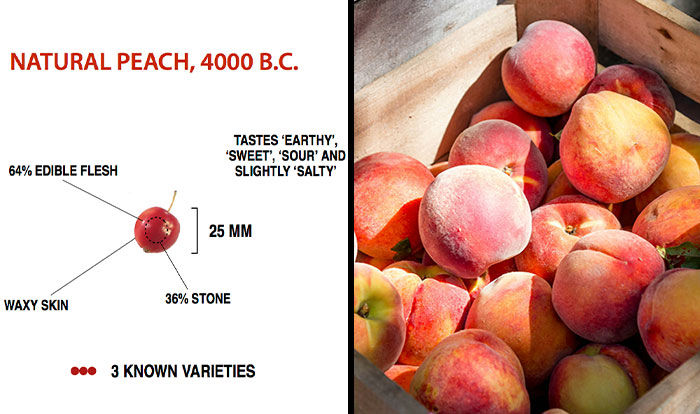 Unlike corn, peaches haven’t changed much since their wild form. Domestication seems to have happened in Japan between 4700 and 4400 BC, and it was done to make the peach pit a bit more compressed.
Unlike corn, peaches haven’t changed much since their wild form. Domestication seems to have happened in Japan between 4700 and 4400 BC, and it was done to make the peach pit a bit more compressed.
Those versions were otherwise fairly similar to the peaches we have today. The ripe and succulent peaches we love fall into either the clingstone or freestone category, which basically tells us whether the fruit’s flesh sticks to its pit or not.
Avocado
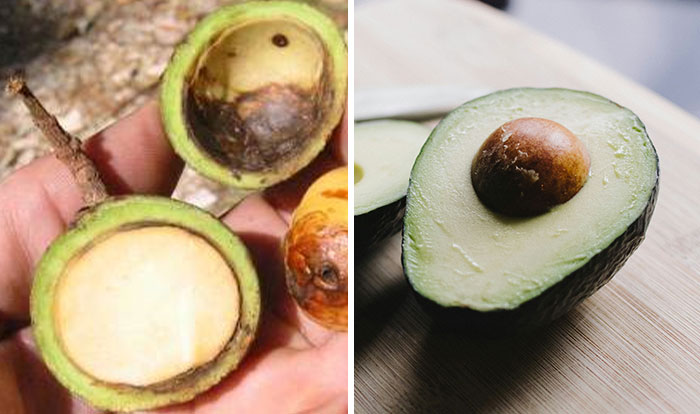 The oldest known avocado dates back almost 10,000 years to central Mexico. This wild fruit used to grow in cave environments and originally had large seeds. It was thought to have been domesticated between 4000 and 2800 BC.
The oldest known avocado dates back almost 10,000 years to central Mexico. This wild fruit used to grow in cave environments and originally had large seeds. It was thought to have been domesticated between 4000 and 2800 BC.
In 1925, an amateur horticulturist named Rudolph Hass grafted different seedlings, which led to the creation of new avocado varieties with dark green, bumpy skin. Now, we have many unique varieties, like the West Indian avocados, which are considered the largest. They are round, have smooth, light green skin, and a slightly sweet taste.
Those were the type of wild avocados I was finding growing in Ecuador, all pit, no fruit. 😖
Grapes
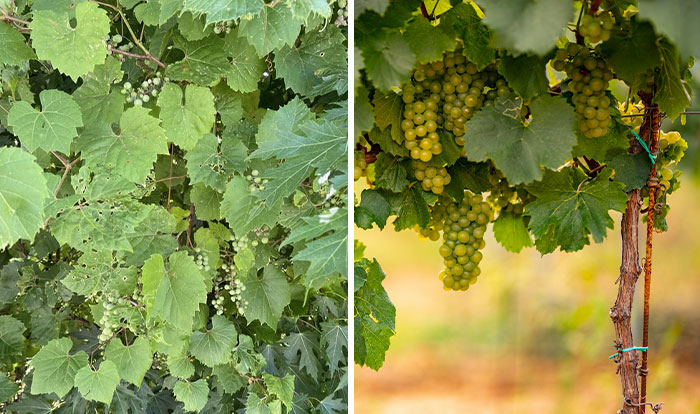 The lovely and large grape vines that we have today are a result of domestication 11,000 years ago in Western Asia and the Caucasus. It was done to yield table and wine grapevines. In the 19th century, a man named Ephraim Bull began selectively breeding grapes that could thrive in cold climates. His work led to the creation of the Concord grapes, which is one of the most widespread varieties in the United States.
The lovely and large grape vines that we have today are a result of domestication 11,000 years ago in Western Asia and the Caucasus. It was done to yield table and wine grapevines. In the 19th century, a man named Ephraim Bull began selectively breeding grapes that could thrive in cold climates. His work led to the creation of the Concord grapes, which is one of the most widespread varieties in the United States.
Grape varieties slowly spread worldwide and now come in different sizes, flavors, and berry-skin colors. Although they haven’t undergone a drastic change, we’re still grateful for these tasty fruits.
Eggplant
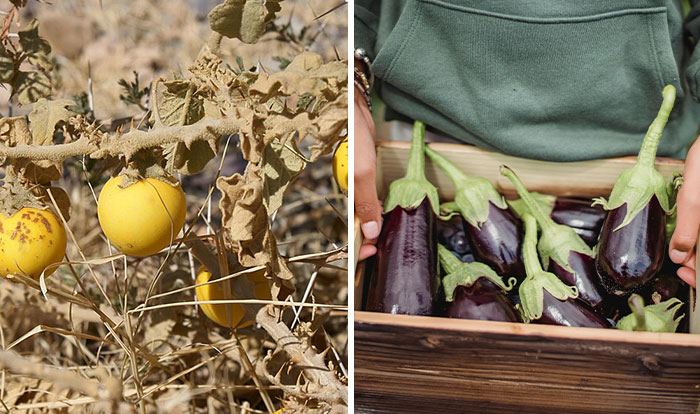 Eggplants might have been domesticated around 59 BC because there are actual written records from ancient China describing the crop. It was only between 7-10th century that eggplant cultivation spread around the world as people started to accept nightshade plants.
Eggplants might have been domesticated around 59 BC because there are actual written records from ancient China describing the crop. It was only between 7-10th century that eggplant cultivation spread around the world as people started to accept nightshade plants.
As cultivation became widespread, the eggplant’s size and shape underwent massive transformations. Older varieties used to have spines on their stems, while others were small, round, and fleshy.
If you plant eggs, you will not get eggplant. It's all a lie!
Tomato
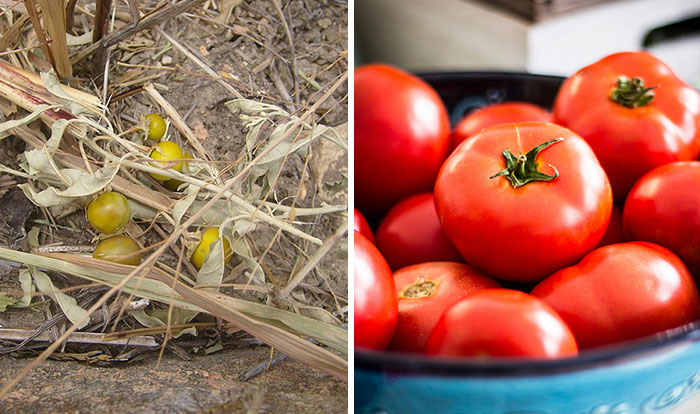 Tomatoes, which are actually considered fruits, not vegetables, were originally quite small and resembled berries. These smaller fruits were later domesticated in Mesoamerica around 7,000 years ago to become the tomatoes we have now.
Tomatoes, which are actually considered fruits, not vegetables, were originally quite small and resembled berries. These smaller fruits were later domesticated in Mesoamerica around 7,000 years ago to become the tomatoes we have now.
The modern red and luscious tomato vastly differs from its tiny ancestor, but its berry versions can still be found today. The species is called Solanum pimpinellifolium or currant tomato and can be found in Ecuador and Peru. Although they are edible, they’re more commonly used for scientific purposes.
You might still be on the fence about genetically modified food, but you’ve got to admit that the process has certainly brought about a lot of spectacular changes. After seeing this list, which of these fruits or vegetables do you think underwent the biggest transformation?
I put this in a comment above, but this article is a reminder that "genetically modified ingredients" means essentially nothing and we've been genetically modifying foods for millenia.
Per the WHO, the definition of a GMO is an organism modified in a way that cannot be achieved by natural means. The results of selective breeding is not a GMO.
Load More Replies...I put this in a comment above, but this article is a reminder that "genetically modified ingredients" means essentially nothing and we've been genetically modifying foods for millenia.
Per the WHO, the definition of a GMO is an organism modified in a way that cannot be achieved by natural means. The results of selective breeding is not a GMO.
Load More Replies...
 Dark Mode
Dark Mode 

 No fees, cancel anytime
No fees, cancel anytime 






















































